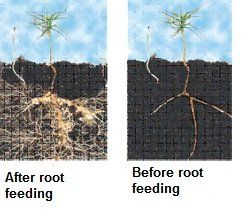Organic Root Feeding
FREE EstimatesISA-Certified ArboristsLicensed and Insured
Give Your Plants and Trees the Nutrients They Need
Root Feeding supplies each tree or plant with a “Deep Root Injection” of organic fertilizer that contains biological fertility additives, micro-nutrients, mycorrhizal fungi, and other beneficial bacteria. The liquid is injected into the ground via high pressure to deliver the mixture to the roots under the surface soil where it is needed most.
“Mycorrhizal fungi” is typically found in forest soil. However, most of today’s landscape environments have been created as part of large construction projects that disturb and possibly remove topsoil where these beneficial mycorrhizal fungi live. Therefore, the soil around us has now been depleted of these beneficial fungi.
We have learned that adding these beneficial fungi back into the soil will help repair soil and aid the root structure of many plants. These fungi live in and around the roots of plants. They serve as a “secondary” root structure that is much thinner but more extensive than the plant’s primary root system and forms a symbiotic relationship. mycorrhizal fungi act as a secondary root system for trees, plants, and shrubs.
This secondary root system provides up to a 700% increase in the plant’s ability to absorb important nutrients and water. Plants with thriving mycorrhizal fungi root structures are better able to survive and grow in stressful environments because these secondary roots are able to extend further into the surrounding soil and absorb, accumulate, and transfer water and mineral elements more efficiently than plants without mycorrhizal fungi.
Regular deep root feeding is necessary to add organic materials and nutrients back into the soil because most organic matter is swept away in manicured environments (leaves, branches, etc) and will not get the chance to break down and give its nutrients back to the host plant. Topical fertilizers take a very long time to get into the root area. Thus limiting the ability to get nutrients to the plant.
Services offered by other companies tend to add high volumes and concentrations of synthetic fertilizers, forcing growth at wrong times of the year and possibly lack of nutrients to support subsequent growth, Leaching of unused synthesized chemicals into the ground and local waterways, while doing little to aid the building of a good long-term organic soil structure.
We use several products that are geared towards certain times of the year to address the issue of what the plant is doing at the time of feeding (leaf production, root expansion, winterization, etc.)
We have seen amazing results with this product and also recommend the inclusion of this product (in granular form) whenever a tree or bush is planted. This product reduces transplant shock.
Call O'Kula Tree Care
to learn more about our tree care services.


